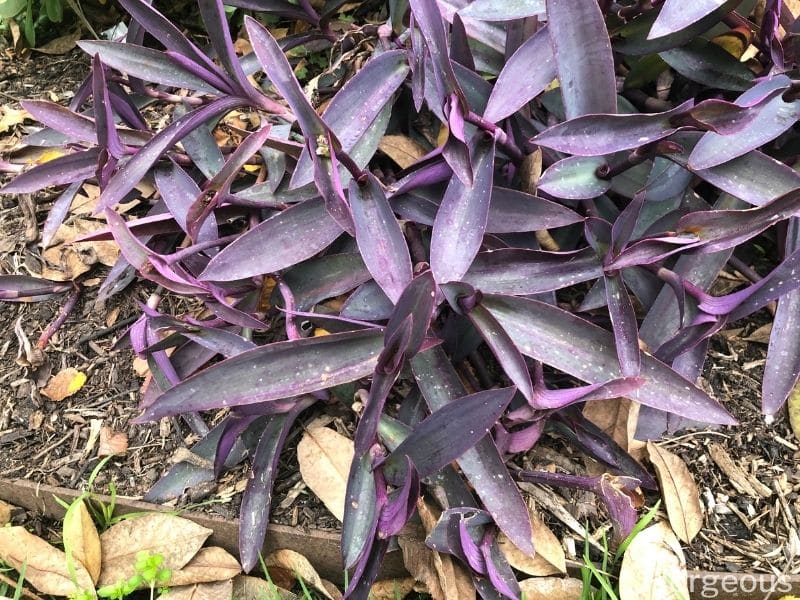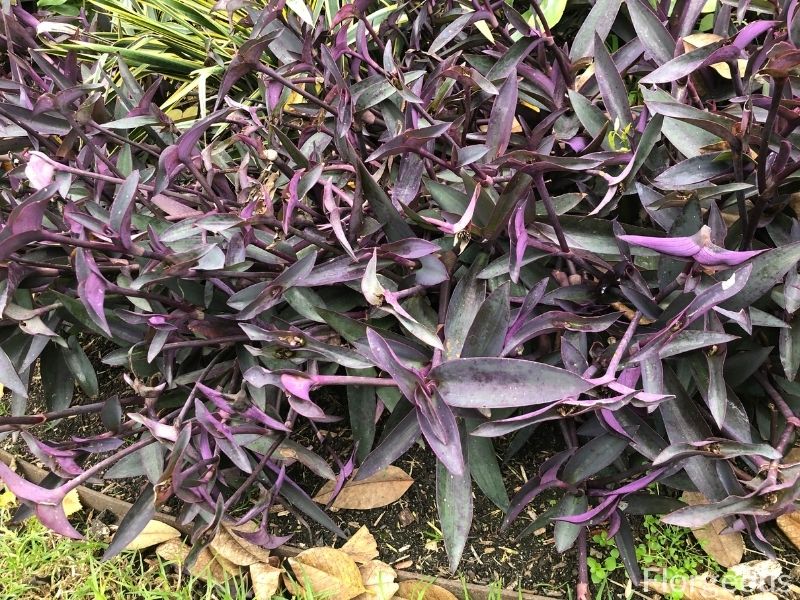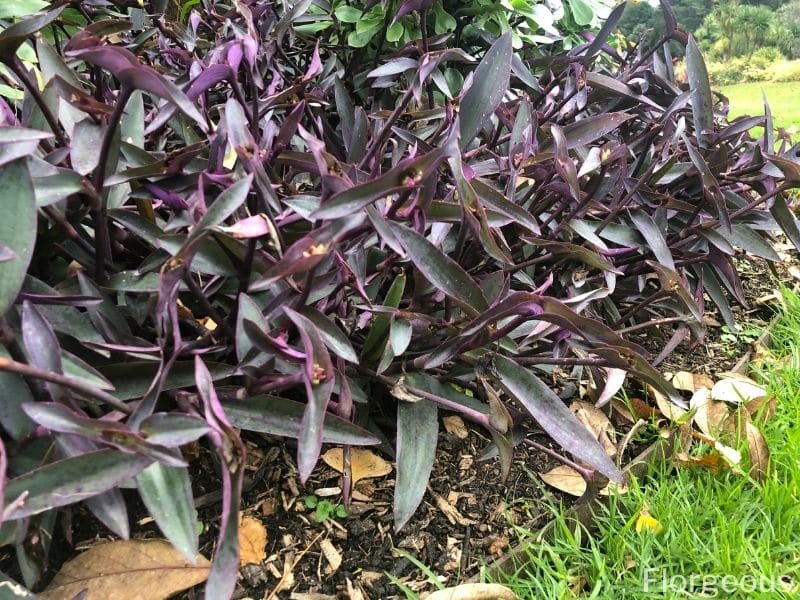So, you’ve stumbled upon those beautiful, vibrant purple plants that someone called “Purple Hearts.” The small pink flowers caught your eye, and you absolutely adore the leaves’ coloration. You’d love to learn how to grow it yourself because you think it’ll make a great addition to your garden.
Great news! We know all about those gorgeous plants and can give you all the info you need to grow it yourself. These plants are called “Tradescantia pallida” – a plant native to Northeast Mexico.
We understand that, as a gardener, your number one priority is being out on the dirt trimming and tending to your plants. So, to make life simpler and help you add these to your garden, we’ve created a compilation of all the things you need to know about Tradescantia pallida.
Take a look and learn how to grow, plant, and care for purple hearts correctly.
What is a Purple Heart Plant?
Purple heart, purple spiderwort, purple queen plant, wandering jew purple heart, and sometimes “Moses-in-the-basket” refer to Tradescantia pallida.

The plant is native to the Tamaulipas and Yucatan regions of Mexico and is characterized by dark purple stems with leaves that grow up to 7” long. Pale hairs cover the top side of the leaves, giving them a fuzzy texture. These plants grow in USDA zones 8-11, making them quite the hardy plant.
Despite their hardiness, these plants have fragile stems that bend over easily. Purple queen plants usually die down onto the ground during the winter and perk back up once spring returns. Their bloom produces small light pink flowers that grow from the ends of the stems in a trinity of pedals, each ½” wide. It’s theorized that the name “Purple Heart” comes from the shape of this flower.
Tradescantia refers to all American plants with flowers that have three pedals, usually the tender kinds grown as trailers and houseplants. The second name, Pallida, comes from the Latin word for “pale,” which helps describe the original form of T. pallida. However, this blog discusses the more common cultivar widely sold in the foliage market.
Purple heart plants make great additions to your gardens as a groundcover, borders, and edging plants. These lovely specimens also serve as attractive indoor plants when in a container or a hanging basket. T. pallida can even fit well in your rock garden.

Types of Tradescantia Pallida
Three common variations of the Tradescantia pallida plant exist today, but there are also other hybrids and variegates this compilation doesn’t include. The types of T. pallida we discuss are commercially sold for their gorgeous purple foliage appearances, though, so we’ll only focus on these for your convenience.
All T. pallida require the same amount of care and respond similarly to sunlight, watering, and other plant care routines.
Be sure to know which type of T. pallida you’re purchasing as well!
T. pallida, “Purpurea”
Purpurea represents the most commercially sold T. pallida variation today. It’s the focus of this blog and what you’ll generally find in flower beds across Florida, Texas, Southern California, and everywhere else in between. These purple hearts are true to their name, with the deepest shade of indigo on their leaves and stem when given ample sunlight. With less sunlight, they’ll turn a deep shade of green with a slight hue of indigo.
T. pallida, “Pale Puma”
Pale Puma represents a hybrid between Tradescantia pallida and Tradescantia sillamontana plants. Pale pumas are visually different from purple hearts in structure with some similarities: pale pumas feature thick, fleshy purple stems that resemble the purpurea. However, pale pumas also feature green, oblong, and rubbery leaves with purplish ends.
The leaves of the pale puma are alternately spaced and appear very different from the conventional purpurea. These plants are known to be deer-resistant and are probably much more durable than the average T. pallida.
Like the Purpurea variety, pale puma turns a deeper shade of purple with more sunlight or full sun. Some versions of Pale Pumas bloom white flowers in October, but most tend to bloom pink flowers just as the other two T. pallida varieties. This variant differs the most from the other two yet still serves similar purposes in flower beds.
T. pallida, “Pink Stripe”
Pink Stripes are a variety of the conventional purple heart plant, with identical structure and flower as the purpurea, yet distinctly bright pink stripes running down the normally violet leaves. These were created through deeper selective breeding of the purpurea purple heart type and make stunning plants to include in your garden. Their pink stripes grow more vibrant with more exposure to sunlight.
One thing noted about the pink stripe variegate is its tendency to revert back to dark pink coloration. Gardeners can prevent complete reversion back to the standard colors of purpurea by trimming away leaves that show signs of regression, but it requires constant upkeep and monitoring. If you’re willing to dedicate the time to maintain the vibrant color, then we recommend growing pink stripes instead of the usual variety.

Growing Purple Queen Plants
Learning to grow your purple heart will take some patience. It’s a delicate plant that can be stubborn to work with. However, once you’ve established your plants, they should grow reasonably quickly.
Purple heart plants can grow up to 1’ in height and 18” in width. For bushier plants, pinch the plant to encourage compact branch and leaf growth. You should also trim the flowers after they bloom to prevent the plant from elongating and thinning out its appearance.
Growing purple hearts alongside other plants in a flowerbed can be troublesome. The plant roots easily, takes in strong sunlight seamlessly, and is drought tolerant despite seeking moisture-rich soil.
Your ground cover plants will survive longer than other bedding plants and dominate the ground they’re rooted in, especially in high-heat climates. Though you might not have to worry about the plant dying after it’s healthy, you’ll have to keep its growth over other plants in check instead.
How to Care for Purple Heart
Purple spiderwort are best suited for cascading baskets, patio containers, or houseplants, if not in-ground, outside in masses. Purpurea should be planted with ample sunlight and partial shade using high organic matter soil: this will keep the moisture evenly distributed during sunny hot days and level during cold winters.
It’s better to plant your flowers in the spring. The warmer weather will help the roots spread without drying out the surrounding soil. Ensure that the soil stays moist during rooting by watering it on hot days. After this, you don’t have to worry much about whether the plant will make it through winter or summer since purple hearts can withstand high temperatures and low-cold climates.
Also, feel free to propagate your purple heart plant with ease. Just cut off any node from the plant and stick it into the ground. Or, if you’d rather let the roots grow out first, leave the node suspended in water and plant the trimming into the soil once roots form.
Be mindful of where you plant your purple heart if you live in a windy environment! The weak stems will easily topple over with strong gusts of winds and die out over time. Even with well-established roots, purple hearts must be kept low to the ground and protected from strong winds to promote vigorous growth.

Caring for Tradescantia Pallida
Maintaining your purple spiderwort is just as important as planting it. While the plant is tough and can survive independently for a reasonable amount of time, it still benefits from regular water, weeding, fertilizing, and pest control. The most vibrant purple heart flowers enjoy a good amount of these plant care routines, so pay close attention to these valuable tips.
Watering
Purple hearts can survive droughts surprisingly well. Whether hot or cold, this plant is a survivor. But you should constantly water your plants to promote strong, thick stems and leaves. Never let the soil your purple heart is planted in go dry. Be wary of watering during colder seasons, though, since you can freeze the plant and kill it.
Don’t worry too much about overwatering either! Purple queen plants tolerate frequent watering as well: killing them by overwatering is difficult given their hardy nature. During summers, these plants need all the water they can get to stay in top shape. Watering your plants often is better than not watering them enough.
Weeding
Weeding shouldn’t be a concern for purple hearts since they rarely die before other bedding plants. T. pallida can overshadow weeds enough that they won’t even be a severe problem. Keep pinching and trimming after a flower bloom to promote bushier branches – this will help protect against any crowding weeds encroaching over your purple heart.
Fertilizing
Purpurea should be fertilized monthly. However, in colder climates or indoors, purple hearts should only be fertilized during the warmer months and not the winter. Reduce water, and don’t re-fertilize your purple hearts until they perk back up in the spring. Also, prioritize full sunlight to keep the leaves from freezing over.
Pests and Diseases
These plants generally don’t suffer from serious diseases, but they have their fair share of pests. Always watch out for aphids, vine weevils, scales, and mealybugs, whether growing the Purple Heart indoors or outdoors. Furthermore, outdoor purple hearts will be eaten by caterpillars, slugs, and snails in your garden hungry for a snack.
Of course, these aren’t all bad for your garden, but never let the feasting get out of hand, or these bugs might kill your purple hearts.
Other Tips for Growing Tradescantia Pallida Flowers
Some other tips for growing Tradescantia pallida purple heart include pairing their deep purple leaves with contrasting colors. Purple heart flowers match well with chartreuse, gold, and variegated foliage. T. pallida also compliments red tints and shades, such as pink, link purple, or burgundy blossoms in neighboring plants. A perfectly positioned purple heart will make all the difference in your garden.
Also, be sure to trim the purple flowers the day after they bloom since they’ll open in the morning and close up by night. We can’t stress enough how the plant stems can elongate if the pale purple flowers are left too long.
Furthermore, be careful with the juice that’s released when cutting or trimming the plant. While the liquid isn’t toxic, it can still cause skin redness or irritation for some people and pets. Allergic reactions may happen; however, don’t let it scare you as a severe problem.
Purple hearts aren’t complex plants to care for and are sure to bring tons of color to your garden or home. Wherever you plant them, be sure to follow these simple steps to planting, growing, and caring for your T. pallida. These are versatile plants that can withstand some of the hottest heat in the United States, so don’t stress getting something wrong your first time around.
FAQs
What temperature can purple heart tolerate?
Purple Heart (Tradescantia pallida) is hardy in USDA zones 7 to 11 and can tolerate temperatures down to approximately 20°F (-6°C). In cooler climates, it’s often grown as an annual or as a houseplant.
Why is my purple heart plant dying?
Common reasons for a dying Purple Heart plant include overwatering, underwatering, poor soil drainage, or exposure to temperatures below its tolerance. Assessing these factors and adjusting care accordingly can help revive the plant.
Is purple heart a good house plant?
Yes, Purple Heart is often grown as a houseplant, particularly in regions with colder climates. It’s appreciated for its trailing habit and vibrant purple foliage. Proper indoor purple heart plant care involves providing bright, indirect light and allowing the soil to partially dry between waterings.
Should I mist my Purple Heart?
Yes, misting your Purple Heart (Tradescantia pallida) occasionally can be beneficial, especially in dry indoor environments. However, ensure that the plant’s soil is not consistently waterlogged, as it prefers well-draining conditions.
We hope you enjoy your new purple hearts! Also to check the wandering jew plant and Tradescantia Nanouk which are similar plants you can grow.






